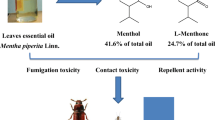Abstract
Six major monoterpenoid constituents of essential oils from aromatic plants grown in Turkey namely, carvacrol, 1,8-cineole, menthol, γ-terpinene, terpinen-4-ol and thymol were tested for their fumigant activity against adults and eggs of the confused flour beetle, Tribolium confusum du Val and larvae and eggs of the Mediterranean flour moth, Ephestia kuehniella Zeller. Doses between 5.8–184.8 mg/l air and exposure periods of 24–96 h were used. All six constituents showed fumigant activity in varying degrees against all tested insect species and their stages. The most active constituent was carvacrol and achieved > 90 % mortality against all test insects at 46.2 mg/l air and an exposure of 24–96 h except for E. kuehniella larvae which required a higher dose, 184.8 mg/l. Although higher doses of 46.2– 184.8 mg/l were necessary, γ-terpinene also caused 99% mortality in all test insects after 26.4–57.5 h. This was followed by thymol and terpinen-4-ol which achieved the same mortality against only one insect species and stage in a dose range of 46.2–184.8 mg/l. The constituents 1,8-cineole and menthol achieved less than 99 % mortality against any insect species tested at doses and exposure periods used. The most tolerant insect stage was E. kuehniella larva and at least a dose of 184.8 mg/l air was needed for 99% mortality with the monoterpenoids tested.
Zusammenfassung
Sechs monoterpene Hauptbestandteile essentieller öle in der Türkei vorkommender Aromapflanzen, Carvacrol, 1,8-Cineol, Menthol, γ-Terpinen, Terpinen-4-ol und Thymol, wurden hinsichtlich ihrer Begasungsmittel-Wirkung gegenüber Adulten und Eiern des Amerikanischen Reismehlkäfers (Tribolium confusum du Val) sowie Larven und Eiern der Mehlmotte (Ephestia kuehniella Zeller) in Dosierungen zwischen 5,8 und 184,8 mg/l Luft und Expositionszeiten zwischen 24 und 96 h untersucht. Alle sechs getesteten Komponenten wirkten mit unterschiedlichem Erfolg als Begasungsmittel gegenüber beiden getesteten Arten und ihren Entwicklungsstadien. Carvacrol als wirksamste Substanz erzielte bei einer Konzentration von 46,2 mg/l Luft und Einwirkzeiten von 24–96 h eine mehr als 90 %ige Mortalität bei allen untersuchten Insekten mit Ausnahme der Eier von E. kuehniella, die eine vergleichbare Mortalität erst bei einer Konzentration von 184,8 mg/l Luft zeigten. Obwohl beim μ-Terpinen höhere Dosierungen von 46,2 und 184,8 mg/l erforderlich waren, wurde mit dieser Substanz nach Einwirkzeiten von 26,4–57,5 h bei allen untersuchten Insekten eine 99 %ige Mortalität beobachtet. Thymol und Terpinen-4-ol bewirkten eine solche Mortalität in einer Dosierung von 46,2–184,8 mg/l nur bei jeweils einem Entwicklungsstadium einer der beiden untersuchten Insektenarten. 1,8-Cineol und Menthol bewirkten mit allen verwendeten Dosierungen und Einwirkzeiten Mortalitäten von weniger als 99 % bei beiden getesteten Arten. Die Larven von E. kuehniella erwiesen sich mit einer Mindestkonzentration von 184,8 mg/l Luft zur Erzielung einer 99 %igen Mortalität als das unempfindlichste der untersuchten Insektenstadien.
Similar content being viewed by others
Literature
Bell, C. H. (2000): Fumigation in the 21st century. Crop Prot. 19, 563–569.
Channoo, C., Tantakom, S., Jiwajinda, S., Isichaikul, S. (2002): Fumigation toxicity of eucalyptus oil against three stored-product beetles. Thai J. Agric. Sci. 35, 265–272.
Erler, F., Tunç, W. (2005): Monoterpenoids as fumigants against greenhouse pests: toxic, development and reproduction-inhibiting effects. Z. Pflanzenkrankh. Pflanzensch. — J. Plant Dis. Protect. 112, 181–192.
Imdorf, A., Kilchenmann, V., Bogdanov, S., Bachofen, B., Beretta, C. (1995): Toxic effects of thymol, camphor, menthol and eucalyptol on Varroa jacobsoni Oud and Apis mellifera L. in a laboratory test. Apidologie 26, 27–31.
Isman, M. B. (2000): Plant essential oils for pest and disease management. Crop Prot. 19, 603–608.
Kumar, S., Hasan, S. A., Dwidei, S., Kukreja, A. K., Sharma, A., Sing, A. K., Sharma, S., Tewari, R. (2001): Toxicity of essential oil from Lippia alba towards stored grain insects. J. Medic. Aromatic. Plant Sci. 22/23 (4A/1A), 117–119.
Lee, B. H., Lee, S. E., Annis, P. C., Pratt, S. C., Park, S. B., Tumaalii, F. (2002): Fumigant toxicity of essential oils and monoterpenes against the red flour beetle, Tribolium castaneum Herbst. J. Asia-Pacific Entomol. 5, 237–240.
Lee, S., Peterson, C. J., Coats, J. R. (2003): Fumigation toxicity of monoterpenoids to several stored product insects. J. Stored Prod. Res. 39, 77–85.
MBTOC (1998): Report of the Methyl Bromide Technical Options Committee. 1998 Assessment of Alternatives to Methyl Bromide. United Nations Environment Programme, Nairobi.
Ojimelukwe, P. C, Adler, C. (1999): Potential of zimtaldehyde, 4-allyl-anisol, linalool, terpineol and other phytochemicals for the control of the confused floor beetle (Tribolium confusum J. d. V) (Col., Tenebrionidae). Anz. Schädlingsk. 72, 81–86.
Rajendran, S., Hajira-Parveen, K. M. (2005): Insect infestation in stored animal products. J. Stored Prod. Res. 41, 1–30.
Regnault-Roger, C, Hamroui, A. (1995): Fumigant toxic activity and reproductive inhibition induced by monoterpenes on Acanthoscelides obtectus (Say) (Coleoptera), a bruchid of kidney bean (Phaseolus vulgaris L.). J. Stored Prod. Res. 31, 291–299.
Rickli, M., Imdorf, A., Kilchenmann, V. (1991): Treatment against varroatosis using compounds of essential oils. Apidologie 22, 417–421.
Saraç, A., Tunc, W. (1995a): Residual toxicity and repellency of essential oils to stored-product insects. Z. Pflanzenkrankh. Pflanzensch. — J. Plant Dis. Protect. 102, 429–434.
Saraç, A., Tunc, W. (1995b): Toxicity of essential oil vapours to stored-product insects. Z. Pflanzenkrankh. Pflanzensch. — J. Plant Dis. Protect. 102, 69–74.
Skinner, J. A., Parkman, J. P., Studer, M. D. (2001): Evaluation of honey bee miticides, including temporal and thermal effects on formic acid gel vapours, in the central south-eastern USA. J. Apic. Res. 40, 81–89.
Sokal, R. R., Rohlf, F. J. (1973): Introduction to Biostatistics. Freeman and Company, San Francisco.
Tunç, İ. (1996): Stored product insect control potential of essential oils. Stored product protection and post-harvest treatment of plant products, Proceedings, International Forum, 7–8 November 1995, Council of Europe, Strasbourg, 137–142.
Tunç, İ., Berger, B. M., Erler, F., Dagli, F. (2000): Ovicidal activity of essential oils from five plants against two stored-product insects. J. Stored Prod. Res. 36, 161–168.
Tunç, İ., Erler, F. (2003): Repellency and repellent stability of essential oil constituents against Tribolium confusum. Z. Pflanzenkrankh. Pflanzensch. — J. Plant Dis. Protect. 110, 394–400.
Tunç, İ., Erler, F., Dagli, F., Çalij, Ö. (1997): Insecticidal activity of acetone vapours. J. Stored Prod. Res. 33, 181–185.
Author information
Authors and Affiliations
Corresponding author
Rights and permissions
About this article
Cite this article
Erler, F. Fumigant activity of six monoterpenoids from aromatic plants in Turkey against the two stored-product pests confused flour beetle, Tribolium confusum, and Mediterranean flour moth, Ephestia kuehniella. J Plant Dis Prot 112, 602–611 (2005). https://doi.org/10.1007/BF03356158
Received:
Accepted:
Published:
Issue Date:
DOI: https://doi.org/10.1007/BF03356158




